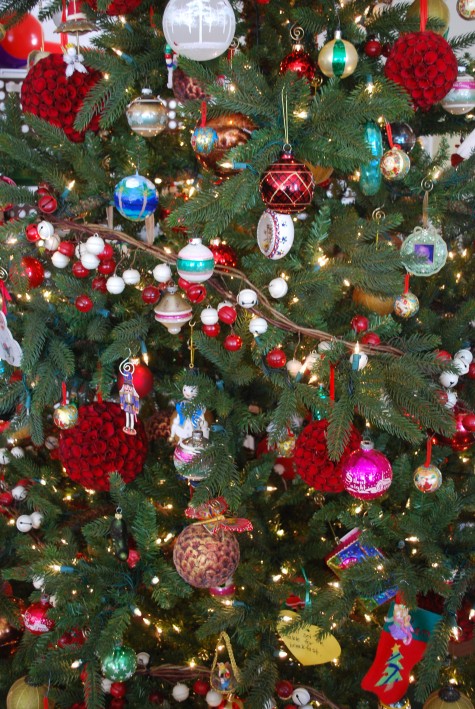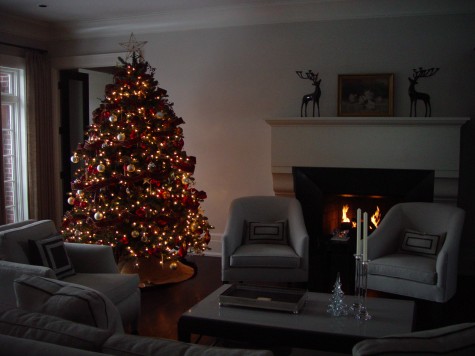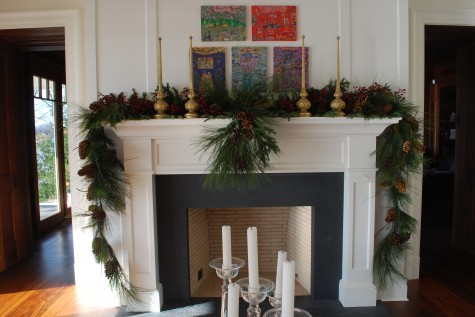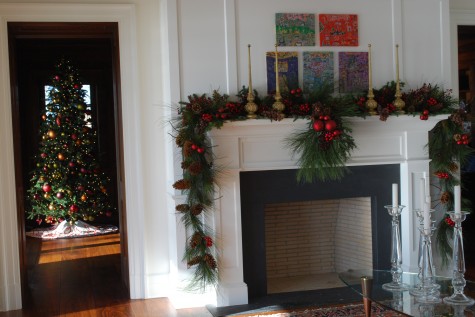
Once the garland is on the mantle, the wreath is up, and the tree is in its stand, it’s time to trim. Though some say there is no art involved in trimming a tree or garland, there are a few things I think make for a more beautiful result. There are no end of choices for trimming. Some people like natural materials or ornament made from natural materials. Some like a little gleam, glitter and glitz. My personal preference-the ability to change things from year to year. But no matter in what manner I might be trimming, I have a method.

I have clients with what I call family history trees. At the very least the ornaments have been collected over a period of years, and represent the history of the family holidays. Some ornament is handmade by children, family members, or friends. A friend has a tree decorated entirely with birds and beasts of every description and in varying materials. The inspiration for this tree? An ornament of an animal that he gave his Mom as a small child he found wrapped in tissue in her jewelry box after he lost her. His tree is about his memories of her, and their relationship. The ornaments for trees like this tend to be all different materials, and all different colors-how can the trimming be done in a cohesive way?

Woody has amassed a collection of spheres of all types and sizes that he adds to the members of his ark. The round shape is repeated all over the tree, giving the tree an overall pattern the eye can make sense of. I should add that he arranges the animals, birds and insects differently every year. One year he organizes by breed, another year he may organize by color. The family tree pictured above is pulled together visually by means of a bell garland that winds its way from top to bottom. The bell garland signals immediately that this is a family tree, designed to delight the children in the household.

Garlands are not only beautiful in their own right, they help stitch a visual project together. Once I have put the individual ornaments on a tree, I will add the garland. I can follow the pattern of the lights, spiral down the tree, or make horizontal or vertical stripes. Good garland is wired everywhere-so individual branchlets can be fluffed out, and stand proud of the silhouette of the tree. If I am installing garland outdoors, I soak a section in water for a while to be sure it can hold up to wet weather.

Ribbon makes a great garland. I like a substantial wiring in both edges of the ribbon, so it will pouf out and stay where I want it. I am one of those ribbon-challenged individuals. I glue my bows together, as the ones I make with my own hands are pretty sorry looking. I’ve been known to shorten pants and upholster chairs with my gluegun too. But wired ribbon makes me look good, as it is easy to arrange. After all, trimming the Christmas tree is supposed to be fun, not frustrating.
 Lynn’s very unusual and striking Christmas tree is a foam form covered in preserved chartreuse leaves. This form is the most important visual element; there are only a few ornaments. The “garland” is actually aluminum wire that floats around the tree like the rings around Saturn. Only every so often is the wire is secured to the tree. The column vase with a ball top-a purchase at Smith and Hawkins many years ago. I filled the bottom of the vase with white sand-this provides a secure base for the tree. Red tinsel garland, and red and green bead garland fill the ball portion of the vase.
Lynn’s very unusual and striking Christmas tree is a foam form covered in preserved chartreuse leaves. This form is the most important visual element; there are only a few ornaments. The “garland” is actually aluminum wire that floats around the tree like the rings around Saturn. Only every so often is the wire is secured to the tree. The column vase with a ball top-a purchase at Smith and Hawkins many years ago. I filled the bottom of the vase with white sand-this provides a secure base for the tree. Red tinsel garland, and red and green bead garland fill the ball portion of the vase.
 This mantle is dressed in a beautifully made artificial pine garland. Finished in Jeffrey pine cones, it has great textural interest. Now what?
This mantle is dressed in a beautifully made artificial pine garland. Finished in Jeffrey pine cones, it has great textural interest. Now what?
 It’s the small bits that bring it to life. Small plain glass balls-shiny and matte-add depth, interest, and density to any trimming project. Clusters of tiny red ornaments look like berries on a tree. Clusters of larger red ornaments hung on the interior of a tree get the tree full of color, just as it is full of light; one’s prized ornaments can be front and center on the tips of the tree branches.
It’s the small bits that bring it to life. Small plain glass balls-shiny and matte-add depth, interest, and density to any trimming project. Clusters of tiny red ornaments look like berries on a tree. Clusters of larger red ornaments hung on the interior of a tree get the tree full of color, just as it is full of light; one’s prized ornaments can be front and center on the tips of the tree branches.

This is a landscape of a different sort, but a landscape, nonetheless.